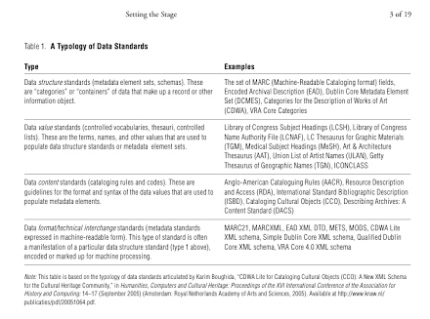According to Anne J. Gilliland in “Setting the Stage,” metadata should contain three elements:
1. Content relates to what the object contains or is about and is intrinsic to an information object.
2. Context indicates the who, what, why, where, and how aspects associated with an objects creation and is extrinsic to an information object.
3. Structure relates to the formal set of associations within or among individual information objects and can be intrinsic or extrinsic or both. (2)
This was easy for me to grasp but to translate this information into the many, many acronyms I have read between my metadata and my cataloging classes was a bit more brainwork. Gilliland helped with her Table, A Typology of Data Standards (3). She lays out each data standard – structure, value, content, and format – along with examples of guidelines pertaining to it. Now, I am not sure how much of this information is more cataloging than metadata, but they have become so intertwined in my mind I am having a hard time separating them. That being said, as I was considering the newly adopted cataloging standard RDA (Resource Description & Access), I was wanting to place that within my metadata knowledge along with FRBR (Functional Requirements for Bibliographic Records). For some reason understanding FRBR was simple…I can grasp the theoretical – the relationships between items.
Gilliland’s table helped me to put it all together. FRBR underscores the standard, its relational concepts underscore it but the standard is the nuts and bolts, so to speak. RDA (and other content standards) tell us what to put where using the value standards of Library of Congress Subject Headings or Medical Subjects Headings among others. The format standard is what makes for interoperability and is how the information is “plugged in” such as MARC or XML. Metadata underscores all of it – it is the data being creating about the data. I hope this makes sense… I am still working it out a bit:-)
Here is Gilliland’s table:

